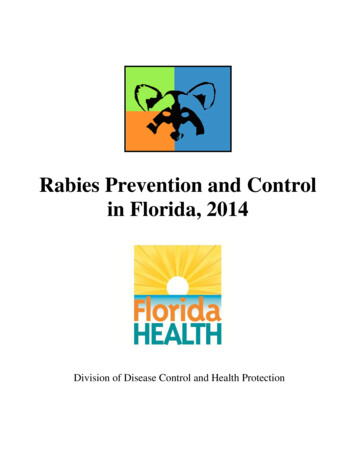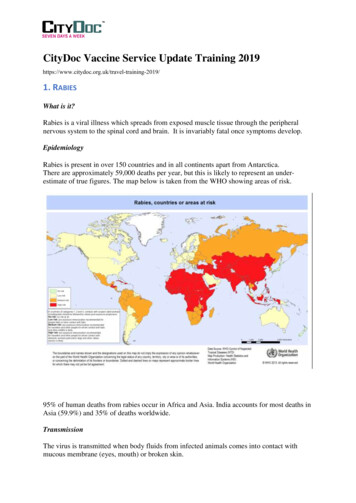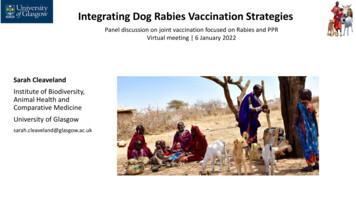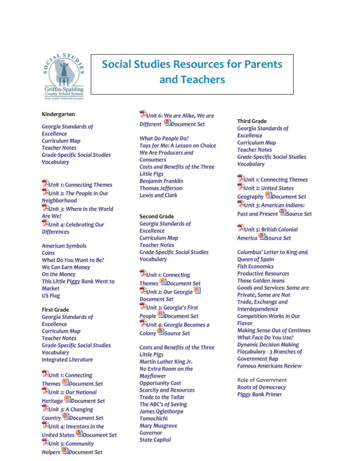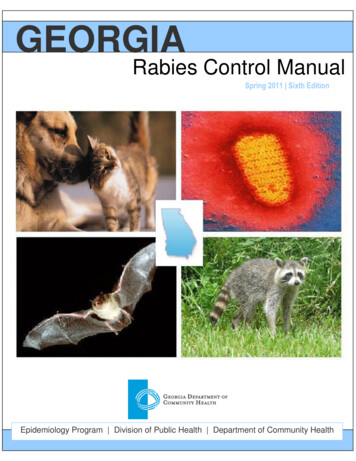
Transcription
GEORGIARabies Control ManualSpring 2011 Sixth EditionEpidemiology Program Division of Public Health Department of Community Health
Table of ContentsPage NumberForewordImportant Phone NumbersI.II.RABIES OVERVIEW4RABIES PREVENTION AND CONTROLA. Legal Authority6B. Principles of Rabies Control6C. CONTROL METHODS IN ANIMALS Animal Vaccination Protocols7 Management of Animals Exposed to Rabies 8 Management of Animals that Bite Humans 10 Protocols--Quick Reference13D. CONTROL METHODS IN HUMANS Rabies Biologics Sources for Rabies Prophylactic Biologics Pre-Exposure Vaccination Post-Exposure Vaccination-Post-Exposure Prophylaxis Regimen Assessing the Need for PEP-PEP and Animal Guide Decision Trees--Quick ReferenceIII.121719192223242627LABORATORY DIAGNOSIS OF RABIESA. General Principles of Diagnosis in AnimalsB. Specimen Collection, Labeling, and SubmissionC. Reporting and Interpreting ResultsD. Serologic Testing32323537IV.RABIES CONTROL DURING DISASTER RESPONSE39V.BATS AND RABIES40VI.FREQUENTLY-ASKED QUESTIONS (FAQ) ABOUT RABIES43VII.REFERENCESA. DefinitionsB. Georgia Rabies Control LawC. Compendium of Animal Rabies Prevention andControl, 2008464851
ForewordThe purpose of this manual is to provide current information on the control of rabiesin Georgia. It is designed to be used by county health departments, hospitalemergency departments, private physicians and health care practitioners,veterinarians, and animal control programs. This manual should serve as aneducational tool for use in all facets of community rabies control. Additionally, it ishoped that this manual will assist communities in standardizing rabies controlpractices within the state.This document was prepared by Cherie L. Drenzek, DVM, MS, Julie Gabel, DVM, MPH,and Melissa Ivey, MPH. Credit is also given to authors of the following: 1) GeorgiaRabies Control Manual, Third, Fourth, and Fifth Editions (1996, 2001, 2007); 2)National Association of State Public Health Veterinarians (NASPHV) Compendium ofAnimal Rabies Prevention and Control 2008, and 3) Use of a Reduced (4-Dose) VaccineSchedule for Postexposure Prophylaxis to Prevent Human Rabies – Recommendationsof the Advisory Committee on Immunization Practices (2010).If you have any questions regarding this manual, please contact the Acute DiseaseSection, Epidemiology Program, Division of Public Health, Georgia Department ofCommunity Health at (404) 657-2588.1
Important Phone NumbersRABIES CONSULTATIONSGeorgia Poison Center- (Atlanta)*Toll Free NumberCounty Health DepartmentsCounty Animal ControlEpidemiology Program, DPH, DCHCDC Clinician Information Line404-616-9000800-222-1222See local phone directorySee local phone directory404-657-2588800-CDC-INFO (800-232-4636)STATE PUBLIC HEALTH LABORATORIESGeorgia Public Health Laboratory (Decatur)Albany Regional LaboratoryWaycross Regional CES FOR RABIES VACCINEsanofi pasteur(Imovax Rabies - HDCV)800-VACCINE is Vaccines and Diagnostics(RabAvert - PCEC)800-CHIRON8 (800-244-7668)www.rabavert.comSOURCES FOR RABIES IMMUNE GLOBULINsanofi pasteur(Imogam Rabies-HT)800-VACCINE is Biotherapeutics(HyperRab S/D)800-243-4153www.talecris-pi.infoINDIGENT PATIENT RABIES VACCINE SUPPORT PROGRAMSBoth rabies vaccine manufacturers have patient assistance programs that providevaccines and medications to uninsured and underinsured patients. These programs areadministered through the Rx Assist Patient Assistance Program Center(www.rxassist.org/patients/default.cfm). The manufacturers may also be contacteddirectly for more information concerning eligibility requirements.sanofi pasteur(Imovax Rabies and Imogam Rabies-HT)866-801-5655Novartis Vaccines and Diagnostics(RabAvert )800-589-08372
SEROLOGIC TESTING FOR HUMANS AND ANIMALS (see pages 37-38)Atlanta Health Associates, Inc.Phone: 800-717-5612309 Pirkle Ferry Road, Suite D300Fax: 770-205-9021Cumming, GA 30040http://atlantahealth.netAuburn UniversityCollege of Veterinary MedicineDepartment of PathobiologyVirology Laboratory261 Greene HallAuburn University, AL 36849Phone: 331-844-2659Fax: 334-844-2652www.vetmed.auburn.edu/virologyKansas State UniversityPhone: 785-532-4483College of Veterinary MedicineFax: 785-532-4474Veterinary Diagnostic Laboratory2005 Research Park CircleManhattan, Kansas x.htmRABIES TAGS*Dogs, cats, and ferrets should be identified (e.g., metal or plastic tags or microchips)to allow for verification of rabies vaccination status.*Licenses/rabies tag requirements are County-based; please contact your County forspecifics.3
I. RABIES OVERVIEWRabies is a viral infection transmitted in the saliva of infected mammals. The virusenters the central nervous system of the host, causing an encephalomyelitis that isalmost always fatal. Although all species of mammals are susceptible to rabies virusinfection, only a few species are important as reservoirs for the disease in nature. Inthe United States, several distinct rabies virus variants have been identified interrestrial mammals, including major terrestrial reservoirs in raccoons, skunks, foxes,and coyotes. In addition to the terrestrial reservoirs for rabies, several species ofinsectivorous bats also serve as reservoirs for the disease.Wildlife is the most important potential source of infection for both humans anddomestic animals in the United States. Reducing the risk of rabies in domestic animalsand limiting contact with wild animals are central to the prevention of human rabies.Vaccination of all domestic dogs, cats, and ferrets, coupled with the systematicremoval of stray animals that are at risk of exposure to rabid wildlife, are basicelements of a rabies control program. Georgia law (Rabies Control Law-O.C.G.A-3119) requires that all owned dogs and cats be vaccinated against rabies by a licensedveterinarian using approved vaccines in accordance with the national Compendium ofAnimal Rabies Prevention and Control (see pages 51-62). Domestic ferrets also needto be vaccinated against rabies according to the national Compendium of AnimalRabies Prevention and Control (see pages 51-62) and Georgia law (O.C.G.A-27-5-5).In the United States, indigenously acquired rabies among humans has declinedmarkedly in recent years. The decline is, in part, due to vaccination and animalcontrol programs begun in the 1940s that have practically eliminated the domesticdog as a reservoir of rabies and also to the development of effective human rabiesvaccines and rabies immune globulin. During 2000-2008, a total of 27 cases of humanrabies were reported in the United States (including one case in Georgia in 2000).Among the 24 cases for which rabies virus variants were obtained, 17 (71%) wereassociated with insectivorous bats, most commonly the Mexican free-tailed, silverhaired, and eastern pipistrelle bats. More than half (53%) of these human casesoccurred during August-November, coincident with a seasonal increase in prevalenceof rabid bats detected in the United States. Despite the substantial number of casesof human rabies attributable to bat exposure, the importance of these exposures isoften overlooked or underestimated. In many of these cases, the bat bite waspresumably not recognized nor the risk of rabies appreciated in order to seekappropriate medical attention.Human rabies is a completely preventable disease if the risk of acquisition isappreciated and appropriate rabies post-exposure prophylaxis (consisting ofwound care as well as both active and passive immunization) is obtained. Becauserabies is a fatal disease, the goal of public health (in coordination with the medicalcommunity) is, first, to prevent human exposure to rabies by education and animalcontrol measures and, second, to prevent the disease by administering rabies postexposure prophylaxis (PEP) if exposure occurs. Tens of thousands of people aresuccessfully treated each year after being bitten by an animal that may have rabies.4
Although the decision to provide post-exposure prophylaxis rests with the patient andhis or her physician, valuable consultations can be provided by the Georgia PoisonCenter, District and County health departments, or the Epidemiology Program,Division of Public Health (see page 2 for contact information).5
II. RABIES PREVENTION AND CONTROLA. Legal AuthorityThe primary responsibility for the control of rabies in Georgia rests with CountyBoards of Health. Chapter 31-19-1 of the Official Code of Georgia Annotated(O.C.G.A.) empowers and requires each County Board of Health to adopt andpromulgate rules and regulations for the prevention and control of rabies (see pages48-50).B. Principles of Rabies ControlAs a zoonotic disease, the foundations of rabies control rest upon preventing thedisease in animals, preventing the disease in humans, and decreasing the likelihood ofexposure between humans and animal rabies vectors. Public education regardingrabies exposure risk is paramount. The following principles apply: Rabies Exposure. Rabies is transmitted only when the virus is introducedinto bite wounds, open cuts in skin, or onto mucous membranes. Human Rabies Prevention. Rabies in humans can be prevented either byeliminating exposures to rabid animals or by providing exposed persons withprompt local treatment of wounds combined with appropriate postexposure prophylaxis (including both passive antibody administration andactive immunization with cell culture vaccines). In addition, pre-exposurevaccination should be offered to persons in high-risk groups, such asveterinarians, animal handlers, and certain laboratory workers. Domestic Animals. Local governments should initiate and maintaineffective programs to ensure vaccination of all dogs, cats, and ferrets andto remove strays and unwanted animals from the community.Recommended vaccination procedures and the licensed animal vaccines arespecified in the Compendium of Animal Rabies Prevention and Control (seepages 51-62). In addition, adjunct procedures which enhance rabies controlinclude: 1) identification systems (e.g., metal/plastic tags, microchips;please refer to individual County requirements) to verify animal rabiesvaccination status; 2) local domestic animal licensure requirements; 3)requirement of interstate health certificates prior to domestic animaltravel; 4) implementation of regulations governing imported domesticanimals; and 5) establishment of a local animal control agency responsiblefor stray control, leash laws, and issuance of citations for failure tovaccinate animals. Rabies in Wildlife. The control of rabies among wildlife reservoirs isdifficult. Vaccination of free-ranging wildlife or selective populationreduction is not always feasible. Rabies control relies upon prevention ofexposure to wildlife rabies reservoirs. This can be accomplished via public6
education about wildlife rabies risk and recommendations regardingavoidance of contact with wild animals. Leash laws and other control ofdomestic animals will reduce exposure of pets to potentially rabid wildlife.C. CONTROL METHODS IN ANIMALSAnimal Vaccination ProtocolsParenteral animal rabies vaccines should be administered only by a licensedveterinarian. This is the only way to ensure that a responsible person can be heldaccountable and to assure the public that the animal has been properly vaccinated.Within 28 days after primary vaccination, a peak rabies antibody titer is reached, andthe animal can be considered immunized. An animal is currently vaccinated and isconsidered immunized if the primary vaccination was administered at least 28 dayspreviously and vaccinations have been administered in accordance with theCompendium of Animal Rabies Prevention and Control (see pages 51-62). Regardlessof the age of the animal at initial vaccination, a second vaccination should beadministered 1 year later. Because a rapid anamnestic response is expected, ananimal is considered currently vaccinated immediately after a booster vaccination. Dogs, Cats, and Ferrets. All dogs, cats, and ferrets should be vaccinatedagainst rabies and revaccinated in accordance with the Compendium ofAnimal Rabies Prevention and Control (see pages 59-60). For many licensedvaccines, the age at primary vaccination is 3 months, but be aware that forsome newer combination rabies vaccines, this age is 8 weeks. If apreviously vaccinated animal is overdue for a booster, it should berevaccinated with a single dose of vaccine and placed on an annual ortriennial schedule, depending on the type of vaccine used. Livestock. Vaccinating all livestock against rabies is neither economicallyfeasible nor justified from a public health standpoint. However, livestockthat are particularly valuable or that have frequent contact with humans,such as show animals or those in petting zoos, should be vaccinated againstrabies (refer to the Compendium of Animal Rabies Prevention and Controlfor specific vaccines licensed for use in livestock, pages 59-60). Horsestraveling interstate or with significant public contact (e.g., riding stables)should be currently vaccinated against rabies. Other Animals.Wild. No parenteral rabies vaccine is licensed for use in wild animals.Because of the risk for rabies in wild animals (especially raccoons,skunks, coyotes, foxes, and bats), the Georgia Department of NaturalResources has rigid regulations which prohibit the keeping of wild andwild/domestic hybrids as pets. For further information, please seewww.dnr.state.ga.us.7
Maintained in Exhibits and in Zoological Parks. Captive animals thatare not completely excluded from all contact with rabies vectors canbecome infected with rabies. Moreover, wild animals might beincubating rabies when initially captured; therefore, wild-caught animalssusceptible to rabies should be placed in strict isolation for a minimumof 6 months before being exhibited. Employees who work with animalsat such facilities should receive pre-exposure rabies vaccination. The useof pre- or post-exposure rabies vaccinations for employees who workwith animals at such facilities might reduce the need for euthanasia ofcaptive animals. Carnivores and bats should be housed in a manner thatprecludes direct contact with the public.Management of Animals Exposed to RabiesAny animal potentially exposed to rabies virus by a wild, carnivorous mammal or a batthat is not available for testing should be regarded as having been exposed to rabies.Dogs, Cats, and Ferrets Unvaccinated dogs, cats, and ferrets exposed to a rabid animal should beeuthanized immediately. If the owner is unwilling to have this done, the animalshould be placed in strict isolation for 6 months and vaccinated either uponentry to isolation OR 1 month before being released. Isolation in this contextrefers to confinement in an enclosure that precludes direct contact withhumans and other animals. Animals overdue for a booster are evaluated on acase-by-case basis that should consider the severity of exposure, timeelapsed since the animal’s last vaccination, number of prior vaccinations,current health status of the animal, and local rabies epidemiology. Strictisolation should be conducted under the authority of the designated localrabies control agency in which the place, manner, and provisions of theconfinement are specified. For example, strict isolation may take place in ananimal control facility or an isolation pen at home, depending on localrequirements. At the first sign of illness or behavioral change in the animal, thelocal rabies control agency should be notified and the animal should beevaluated by a veterinarian. If clinical signs are suggestive of rabies, theanimal should be immediately euthanized and tested for rabies. Currently vaccinated (see Definitions, pages 46-47) dogs, cats, and ferretsshould be revaccinated immediately, kept under the owner's control, andobserved at home for 45 days for clinical signs of rabies. During the observationperiod (see Definitions, pages 46-47) the animal should not be permitted toroam freely and should be restricted to leash walks, if applicable. At the firstsign of illness or behavioral change in the animal, the local rabies controlagency should be notified and the animal should be evaluated by aveterinarian. If clinical signs are suggestive of rabies, the animal should beimmediately euthanized and tested for rabies.8
Livestock All species of livestock are susceptible to rabies; cattle and horses are the mostfrequently infected. Livestock exposed to a rabid animal and currentlyvaccinated with a vaccine approved by USDA for that species (see pages 59-60)should be revaccinated immediately and observed for 45 days. Unvaccinated livestock should be euthanized immediately. If the animal is noteuthanized it should be kept under close observation for 6 months. Any illnessin an animal under observation should be reported immediately to the localhealth department. If signs suggestive of rabies develop, the animal should beeuthanized and the head shipped for testing as described in Part I.A.8.of theCompendium of Animal Rabies Prevention and Control (see page 53). Handling and consumption of tissues from exposed animals may carry a risk forrabies transmission. Risk factors depend in part on the site(s) of exposure,amount of virus present, severity of wounds, and whether sufficientcontaminated tissue has been excised. If an exposed animal is to beslaughtered for consumption, it should be done immediately after exposure andall tissues should be cooked thoroughly. Barrier precautions should be used by persons handling the animal and tissues.Historically, federal guidelines for meat inspectors required that any animalknown to have been exposed to rabies within 8 months be rejected forslaughter. USDA Food and Inspection Service (FSIS) meat inspectors should benotified if such exposures occur in food animals prior to slaughter. Rabies virus may be widely distributed in tissues of infected animals. Tissuesand products from a rabid animal should not be used for human or animalconsumption. However, pasteurization temperatures will inactivate rabiesvirus; therefore, drinking pasteurized milk or eating thoroughly cooked animalproducts does not constitute a rabies exposure. Multiple rabid animals in a herd or herbivore-to-herbivore transmission isuncommon; therefore, restricting the rest of the herd if a single animal hasbeen exposed to or infected by rabies is usually not necessary.Other Animals Other animals bitten by a rabid animal should be euthanized immediately.Animals maintained in USDA-licensed research facilities or accreditedzoological parks should be evaluated on a case-by-case basis. Consultations canbe provided by the Epidemiology Program, Division of Public Health.9
Management of Animals that Bite HumansDogs, Cats, and Ferrets Rabies virus may be excreted in the saliva of infected dogs, cats, and ferretsduring illness and/or for only a few days prior to illness or death. A healthydog, cat, or ferret that bites a person should be confined (see Definitions,pages 46-47) and observed for 10 days, no matter if the animal is currentlyvaccinated or not. Administration of rabies vaccine is not recommendedduring the confinement period to avoid confusing signs of rabies with possibleside effects of vaccine administration. Confinement (sometimes referred to as quarantine) conditions should preventdirect contact with other animals or persons. The confinement shall beconducted under the authority of the designated local rabies control agency inwhich the place, manner, and provisions of the confinement are specified. Forexample, confinement may take place in a kennel in a veterinary hospital,animal control facility, commercial boarding establishment, or a pen at home,depending on local requirements. At the first sign of illness or behavioral change in the animal, the local rabiescontrol agency should be notified and the animal should be evaluated by aveterinarian. If clinical signs are suggestive of rabies, the animal should beimmediately euthanized and tested for rabies and the exposed person notified. Any stray or unwanted dog, cat, or ferret that bites a person may beeuthanized immediately (or following the locally-specified impoundment periodto give owners sufficient time to claim animals) and the head submitted forrabies examination.Other biting animals (wild animals, animals maintained in zoological parks, canineor feline wild/domestic hybrids, etc.) No parenteral rabies vaccines are licensed for use in animals other than dogs,cats, ferrets, and some livestock. Since the duration of clinical signs and the period of virus shedding areunknown for many species, confinement may not be a feasible managementstrategy. Most wild mammals that bite or otherwise expose persons should beconsidered for euthanasia and rabies examination. Prior vaccination of ananimal might not preclude the necessity for euthanasia and testing if theperiod of virus shedding is unknown for that species.10
Management of animals other than dogs, cats, and ferrets depends on thespecies, the circumstances of the bite, the epidemiology of rabies in the area,and the biting animal's history, current health status, and potential forexposure to rabies.The Epidemiology Program, Division of Public Health, should be consulted whencircumstances warrant.Wildlife Most wild mammals that bite or otherwise expose persons should beconsidered for euthanasia and rabies examination. Since the duration ofclinical signs and the period of virus shedding are unknown for these species,an appropriate confinement or isolation period cannot be ascertained.Assessing rabies risk and the need for rabies diagnostic testing can be guided bythe following: Wild Carnivores. Raccoons, skunks and foxes are the terrestrial animalsmost often infected with rabies. All bites by such wildlife mustbe considered possible exposures to the rabies virus. Signs of rabies amongwildlife cannot be interpreted reliably; therefore, any such animal thatexposes a person should be euthanized at once (without unnecessarydamage to the head) and the brain should be submitted for rabies testing. Rodents and Lagomorphs. Squirrels, rats, mice, hamsters, guinea pigs,gerbils, chipmunks, and rabbits are almost never found to be infectedwith rabies and have not been known to transmit rabies to humans. Bitesby these animals are usually not considered a rabies risk and do notwarrant rabies testing unless the animal is sick or behaving in an unusualmanner. Rodents that are considered to be a rabies risk includewoodchucks or groundhogs (Marmota monax) because they are frequentlylarge enough to survive the attack of a rabid carnivore. Approval must beobtained from the Georgia Public Health Laboratory or theEpidemiology Program of the Division of Public Health prior tosubmitting a rodent for rabies testing. Bats. A bat that bites, scratches, or has any direct physical contact with aperson should be safely captured (see page 41 for instructions),immediately euthanized, and the entire animal sent to the laboratory forrabies examination. People usually know when they have been bitten by abat. However, because bats have small teeth that may leave marks thatare not easily seen, there are situations in which rabies testing andmedical advice should be sought even in the absence of an obvious bitewound. These include awakening to find a bat in the room, finding a bat inthe room of an unattended child, having a bat physically brush againstyou, or finding a bat near a mentally impaired or intoxicated person. In11
these situations a bite cannot be definitively ruled out. If physicalcontact occurs or the situations above occur and the bat is not availablefor testing (i.e., escapes from house), rabies post-exposure prophylaxisshould be administered as soon as possible. Other wild animals. In most situations involving non-reservoir species(opossums, otters, polecats, beavers, weasels, etc.), the rabies risk isrelatively low. The risk is higher and, consequently, rabies testing may beindicated if the animal is found in a rabies-endemic area, has opportunityfor exposure to rabies reservoirs, is large enough to survive an attack by arabid animal, or is ill or exhibiting abnormal behavior (for example, manyrabid bobcats have been found in Georgia).12
PROTOCOL FOR LIVESTOCK POSSIBLY EXPOSED TO RABIESLivestock exposed to bat or otherwild carnivorous mammal *Exposed livestockdoes not have current rabiesvaccinationExposed livestock has currentrabies vaccination **Revaccinate immediately & haveowner observe for 45 daysTest bat or other wild carnivorousmammal ***Submit head for rabies testing ifanimal becomes ill with signssuggestive of rabies or dies duringobservation periodResult is positiveResult is negativeImmediate slaughter ofexposed livestockVaccinate livestockagainst rabiesIf Owner Refuses Euthanasia:1.2.3.4.Close observation for 6 months.Neither tissues nor milk from a rabid animal should be usedfor human or animal consumption.Test livestock if it becomes ill with signs suggestive ofrabies or dies during confinement period.Federal guidelines for meat inspectors require that anyanimal known to have been exposed to rabies within 8months be rejected for slaughter.NOTE: Herbivore-to-herbivore transmission is rare. Restriction of therest of the herd may not be necessary.*Consultations regarding animal exposures can be provided by the EpidemiologyProgram of the Division of Public Health at 404-657-2588.** An animal is currently vaccinated if the primary rabies vaccine (USDA-approvedfor use in livestock species) was administered by a veterinarian at least 28 dayspreviously and booster vaccines have been administered according to vaccine label.***If bat or wild animal is NOT available for testing, must proceed as if result ispositive.13
PROTOCOL FOR DOGS, CATS, AND FERRETS POSSIBLY EXPOSED TORABIESDog/Cat/Ferret exposed to bator other wild carnivorous mammal*Exposed dog/cat/ferrethas current rabies vaccination **Exposed dog/cat/ferretdoes not have current rabiesvaccinationRevaccinate immediately & haveowner observe for 45 daysTest bat or other wild carnivorousmammal***Submit head for rabies testing ifanimal becomes ill with signssuggestive of rabies or dies duringobservation periodResult is positiveResult is negativeImmediate euthanasia ofexposed dog/cat/ferretVaccinatedog/cat/ferretagainst rabiesIf Owner Refuses Euthanasia:1.2.3.*Strict isolation for 6 months.Vaccinate for rabies upon entry toisolation OR at month 5 of isolation.Submit head for rabies testing if thedog/cat/ferret becomes ill with signssuggestive of rabies or dies duringisolation period.Consultations regarding animal exposures can be provided by the EpidemiologyProgram of the Division of Public Health at 404-657-2588.** An animal is currently vaccinated if the primary rabies vaccine was administered by aveterinarian at least 28 days previously and booster vaccines have been administeredon an annual or triennial schedule. Animals overdue for a booster are evaluated on acase by case basis (e.g., severity of exposure, time elapsed since last vaccination,number of prior vaccinations, current health status, and local rabies epidemiology).***If bat, attacking dog, or wild animal is NOT available for testing, must proceed as ifresult is positive.14
PROTOCOL FOR COMPANION ANIMAL-TO-COMPANION ANIMALEXPOSURES/ENCOUNTERSNote: Because the United States has been declared free of canine rabies virus variant transmission, healthy dog-todog, dog-to-cat, or cat-to-cat encounters are not generally considered a rabies risk.Companion animal (dog or cat) bites/attacksanother companion animalAttacking animal showing neurologic signs orsigns suggestive of rabies?NOYES1) Submit attacking animal’s head for rabies testing.2) Confine the other animal according to local protocols untilresults are available.No isolation, confinement,or rabies testing necessary1) Notify animal control agencyif stray.Result is positiveResult is negative2) Use as reminder to vaccinateanimals against rabies ifneeded.STOP. Vaccinateagainst rabies ifneeded.Attacked animal hascurrent rabies vaccineAttacked animal does not havecurrent rabies vaccineBoost with 1 dose of rabies vaccine andobserve at home for 45 daysEuthanize or strict isolation for 6 months, asabove15
RABIES PROTOCOL FOR ANIMALS WHICH HAVE BITTEN PEOPLEPerson Exposed (bitten, scratched, or other*) by: (Refer person to physician)Wildlifehybrid**Wild terrestrialmammal**Owned dog or cat(vaccinated orunvaccinated)Stray dog or cat(vaccination statusunknown)Animal showingsigns of rabiesHealthy animalConfine andobserve for10 daysTest if animal becomesill with signs suggestiveof rabies or dies duringconfinement*BatEuthanize &Euthanize & testtestonly if animal clearly immediatelyexhibits signs ofrabiesEuthanize animal & test ifappropriate species ***Owner wantsanimalLivestockOwner Doesn'tWant AnimalEuthanize &testEuthanize &testHealthy animalImpound according tolocal protocols theneuthanize & testTest if animal becomes illwith signs suggestive ofrabies or dies duringconfinementAlternatively, animal may beconfined for 10 days and, if itremains healthy, may euthanizewithout testingConsultations regarding exposure can be provided by the Georgia Poison Center, 24 hours a day, 7 days a week, at 1-800222-1222 or 404-616-4000.** No parenteral rabies vaccines are licenses for use in wild animals or hybrids (the offspring of wild animals crossbred todomestic animals). Wild animals or hybrids should not be kept as pets. Prior vaccination of these animals does not precludethe necessity for euthanasia and testing.*** The following animals are NOT CONSIDERED LIKELY TO HAVE RABIES and will not be tested except by specialarrangements with the Epidemiology Program of the Georgia Division of Public H
-PEP and Animal Guide 26 Decision Trees--Quick Reference 27 III. LABORATORY DIAGNOSIS OF RABIES A. General Principles of Diagnosis in Animals 32 B. Specimen Collection, Labeling, and Submission 32 C. Reporting and Interpreting Results 35 D. Serologic Testing 37 IV.
